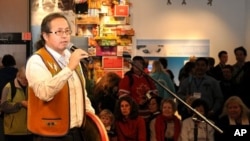One of the Inuit people's native symbols is being used as the the logo for the Vancouver Winter Olympics. Members of the indigenous tribe live in some of the most beautiful and isolated parts of Canada. The Inuit and other native peoples of Canada's far northern region are making a special effort to introduce themselves to the world.
Canada's northernmost territories - Yukon, Northwest Territories and Nunavut - cover more than 3.5 million square kilometers. But fewer than 100,000 people live there.
As part of their efforts to improve their exposure and relationships with people worldwide, the Inuit and other native peoples of the region are hosting Canada's Northern House in downtown Vancouver.
The facility opened in mid-January and has been a popular destination during the Winter Games. Northern House highlights life near the Arctic Circle and features exhibits on native clothing, hunting, music, mining and exploration.
Jerry Antoine is a Dene drummer and storyteller. Raised in Rabbitskin River, more than 2,100 kilometers north of Vancouver, he has devoted himself to preserving the stories and traditions of the Dene people.
He tells a group of visitors to Northern House that storytelling plays a vital role in the Dene culture.
"We can't only listen once. We've got to listen twice because sometimes when the stories are told, you hear something and you learn something. When you grow, you hear it again and you also get another message," he explained.
Michael Kusugak is an award-winning children's author living in Rankin Inlet, Nunavut. The eldest of 12 children, he was born in a sod hut near Repulse Bay and spent his early years living in the nomadic tradition of the Inuit.
With bright eyes and an engaging smile, he says songs and stories were vital to survival when his family lived in igloos above the Arctic Circle.
"And we developed this system of expressing ourselves in a song called a Pisiq. And those were actually created when our people were out on a dogsled in the moonlight. So you get inspired by that kind of thing and so we developed these songs," he said.
Kusugak says that the Inuit symbol used to represent the Vancouver Winter Games serves a special purpose in his culture, illustrating that his people were in the region, where to find food or whether there is fuel for fire.
"So it's a stone person standing on a hill and that is the official symbol of these Olympic Games in Vancouver and up in Whistler. And that's why we are here [at Northern House] - to present our culture to the people of the world," he said.
Because some of the countries competing in Vancouver border the Arctic Circle, Michael Kusugak says similar stories can be found in Russia, Mongolia, Finland, Sweden and other nations.
The Inuit storyteller recalls a time when he told an ancient story about Kiviuq, a character in Inuit legend.
"I met a blonde man and he said, 'That's a very interesting word.' And I said, 'What word is that?' And he said, 'Kiviuq!' And I said, 'What do you mean?' And he said, 'We have a word just like that.' And I said, 'Where are you from?' And he said, 'Finland,'" he said.
Canada's Northern House exhibit is open throughout the Games. Visitors can see examples of northern people's clothing, transportation and art - including sculpture made from soapstone, whale bone and caribou horn - as well as view native diamond polishing. The center has been a popular gathering place, hosting more than 30,000 visitors since it opened









